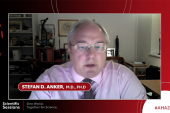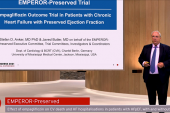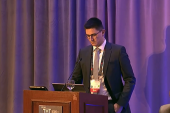HF Triple Therapy Doesn’t Seem Effective in True Preserved HF
An analysis tallying up the benefits of MRAs, ARNIs, and SGLT2 inhibitors offers fresh fodder for the debate over LVEF definitions.

The combined benefits of a mineralocorticoid receptor antagonist (MRA), an angiotensin receptor-neprilysin inhibitor (ARNI), and a sodium-glucose cotransporter 2 (SGLT2) inhibitor in patients with mildly reduced ejection fraction (EF) are likely “substantial” and similar to that seen in patients with reduced EFs, according to a cross-trial analysis of the TOPCAT, PARAGON-HF, and EMPEROR-Preserved trials.
Where these drugs in combination are likely not to be of benefit is in patients with EFs over 65%, said Muthiah Vaduganathan, MD (Brigham and Women’s Hospital, Boston, MA), who presented the analysis at the European Society of Cardiology Heart Failure (ESC-HF) 2022 congress earlier this week.
The study was published simultaneously, as a research letter, in Circulation.
“These data further support recent calls to reevaluate heart failure nomenclature and the upper LVEF bounds to define heart failure with midrange ejection fraction,” Vaduganathan said.
Speaking with TCTMD, Vaduganathan pointed out that current guidelines define that middle range as between 40% and 50%, but “these data do introduce questions of whether we should extend that upwards to 60% or 65%, with the idea that really most patients with heart failure likely benefit from combination.”
He continued: “There are clear and very substantial benefits of combination medical therapy in heart failure with reduced ejection fraction that's below or equal to 40%, but we actually found benefits almost of a comparable magnitude of benefit with this combination of therapies, up to a range between 60% and 65%.”
For their study, the investigators analyzed the combined trial data according to three LVEF subgroups: 45% to 54%, 55% to 64%, and 65% or greater, constructing composite splines to describe variations in treatment benefits across the EF spectrum.
In these models, switching from a renin-angiotensin-aldosterone-system (RAAS) inhibitor to an ARNI, adding an MRA, and then adding an SGLT2 inhibitor would cut the risk of a cardiovascular death or hospitalization by half (HR 0.49; 95% CI 0.32-0.74) in patients with a LVEF in the range of 45% to 54%. For those with LVEFs in the range of 55% to 64%, the reduction in this composite endpoint was almost equally powerful (HR 0.54; 95% CI 0.37-0.80). In patients in the LVEF ≥ 65% range, however, no benefit was seen with combination therapy (HR 1.17; 95% CI 0.65-2.10).
Targeting Therapies
Commenting on the findings for TCTMD, Andrew Sauer, MD (Saint Luke's Mid America Heart Institute, Kansas City, MO), pointed out that similar stand-alone modeling studies were done for ARNIs in PARAGON-HF and for MRAs in TOPCAT, so to see these effects for all three drugs in combination makes sense. The signal, he pointed out, is driven primarily by reductions in hospitalizations, and not as much by cardiovascular deaths, which as a single endpoint were significantly reduced in the LVEF 45% to 54% group, but not the other EF categories.
The lack of benefit in the higher ranges, said Sauer, likely reflects the underlying mechanisms of benefit of these agents. “I categorize these three drugs as the ‘decongestive’ guideline-based medical therapies, as opposed to beta-blockers, ACE inhibitors, and angiotensin II receptor blockers, which probably have more prolonged reverse-remodeling effects,” he said. That “decongesting immediacy” is likely part of the reason they are working in these higher EF ranges.
This analysis, Sauer continued, should reassure physicians that these drugs in combination can be used in these higher EF ranges, particularly since both PARAGON-HF and TOPCAT did not meet their primary endpoints.
“There's a lot of caveats, but I think that there's power to these estimates in terms of emboldening us to use these therapies, particularly for those patients in that lower ejection fraction range of what some people consider the midrange or what has been traditionally considered the lower range of HFpEF,” he said.
On the other hand, in the higher range of true HFpEF, Sauer suggested it may be time to consider this as a disease “that’s very different from traditional heart failure.”
“Maybe for the EFs of 65% and higher, the disease is clearly not all cardiac,” he said. “You're dealing with obese patients who have preserved ejection fraction who also have lung disease, who have liver disease, who have chronic kidney disease, and they tend to be quite elderly,” he said. “Is it realistic to expect that any single therapy or even potential combined therapy would work, that doesn't have a precise target looking at the cardiac pathophysiology? I think it may be very difficult to find a therapy that isolates that in a pill.”
Vaduganathan, too, stressed that only the SGLT2 inhibitors have been shown to have benefits in the higher EF ranges, and that likely stems at least in part from their “multisystem benefits . . . outside the heart, including the kidneys, the liver, the adipose tissue. And so all those aspects may not be totally dependent on the heart and left ventricular function.”
More Data Coming
This picture will likely gain more clarity in the months and years to come, Vaduganathan noted. “Additional large trials are underway to improve precision with these estimates, especially in this higher LVEF range above 65%.”
Following Vaduganathan’s ESC-HF presentation, session chair Maja Cikes, MD, PhD (University Hospital Centre Zagreb, Croatia), asked if it might be time to “unite” the HFrEF and “mildly reduced” populations, while also pinning down the upper limit of benefit for heart failure therapies.
Vaduganathan agreed, saying: “I think there’s growing appreciation that this mildly reduced EF range likely has very similar pathophysiological drivers and characteristics and even treatment response to reduced EF, and likely the same recommendations would hold for heart failure with reduced and mildly reduced ejection fraction.”
That said, he continued, “better characterization of that very high EF range is going to be important.” While empagliflozin didn’t show much in the way of attenuation of benefit even at the upper EF ranges, “we’ll learn more from DELIVER, which will be soon to report, especially in this high EF range,” he predicted.
Shelley Wood was the Editor-in-Chief of TCTMD and the Editorial Director at the Cardiovascular Research Foundation (CRF) from October 2015…
Read Full BioSources
Vaduganathan M, Claggett BL, Inciardi RM, et al. Estimating the benefits of combination medical therapy in heart failure with mildly reduced and preserved ejection fraction. Circulation. 2022;Epub ahead of print.
Disclosures
- Vaduganathan reports receiving research grant support or serving on advisory boards for American Regent, Amgen, AstraZeneca, Bayer AG, Baxter Healthcare, Boehringer Ingelheim, Cytokinetics, Lexicon Pharmaceuticals, Novartis, Pharmacosmos, Relypsa, Roche Diagnostics, and Sanofi; having speaker engagements with Novartis and Roche Diagnostics; and participating on clinical trial committees for studies sponsored by Galmed, Novartis, Bayer AG, Occlutech, and Impulse Dynamics.
- Sauer reports receiving research funding and speaking honoraria from Novartis, and research funding from Boehringer Ingelheim for EMPEROR-Preserved, neither of which were in the last 12 months.





Comments